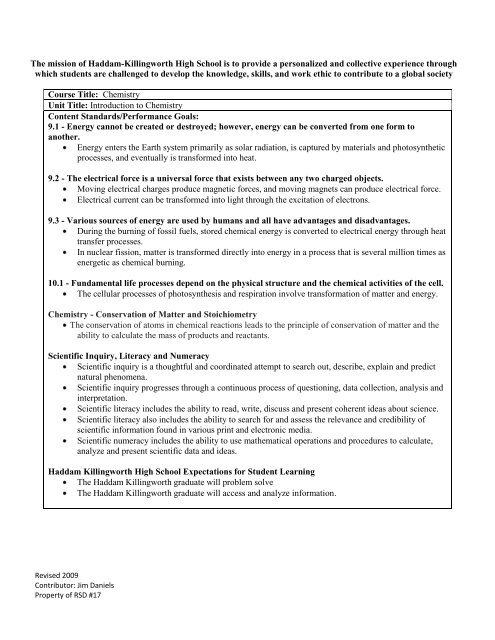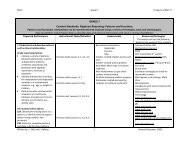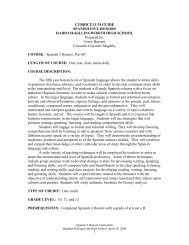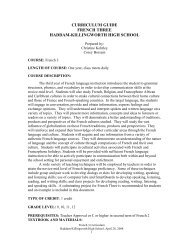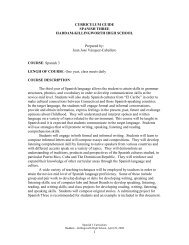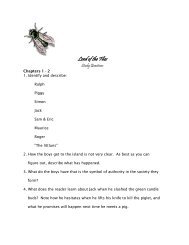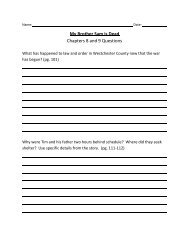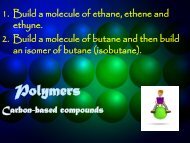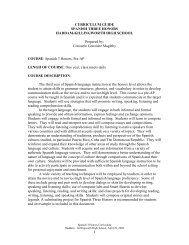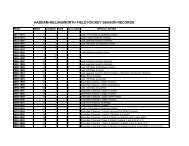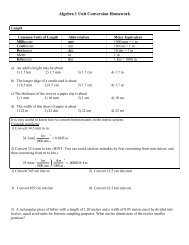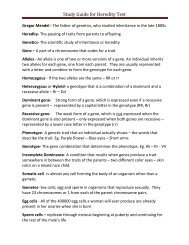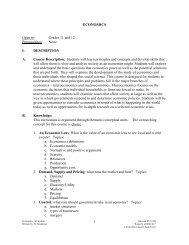Chemistry - College Prep
Chemistry - College Prep
Chemistry - College Prep
- No tags were found...
Create successful ePaper yourself
Turn your PDF publications into a flip-book with our unique Google optimized e-Paper software.
The mission of Haddam-Killingworth High School is to provide a personalized and collective experience throughwhich students are challenged to develop the knowledge, skills, and work ethic to contribute to a global societyCourse Title: <strong>Chemistry</strong>Unit Title: Introduction to <strong>Chemistry</strong>Content Standards/Performance Goals:9.1 - Energy cannot be created or destroyed; however, energy can be converted from one form toanother.Energy enters the Earth system primarily as solar radiation, is captured by materials and photosyntheticprocesses, and eventually is transformed into heat.9.2 - The electrical force is a universal force that exists between any two charged objects.Moving electrical charges produce magnetic forces, and moving magnets can produce electrical force.Electrical current can be transformed into light through the excitation of electrons.9.3 - Various sources of energy are used by humans and all have advantages and disadvantages.During the burning of fossil fuels, stored chemical energy is converted to electrical energy through heattransfer processes.In nuclear fission, matter is transformed directly into energy in a process that is several million times asenergetic as chemical burning.10.1 - Fundamental life processes depend on the physical structure and the chemical activities of the cell.The cellular processes of photosynthesis and respiration involve transformation of matter and energy.<strong>Chemistry</strong> - Conservation of Matter and StoichiometryThe conservation of atoms in chemical reactions leads to the principle of conservation of matter and theability to calculate the mass of products and reactants.Scientific Inquiry, Literacy and NumeracyScientific inquiry is a thoughtful and coordinated attempt to search out, describe, explain and predictnatural phenomena.Scientific inquiry progresses through a continuous process of questioning, data collection, analysis andinterpretation.Scientific literacy includes the ability to read, write, discuss and present coherent ideas about science.Scientific literacy also includes the ability to search for and assess the relevance and credibility ofscientific information found in various print and electronic media.Scientific numeracy includes the ability to use mathematical operations and procedures to calculate,analyze and present scientific data and ideas.Haddam Killingworth High School Expectations for Student LearningThe Haddam Killingworth graduate will problem solveThe Haddam Killingworth graduate will access and analyze information.Revised 2009Contributor: Jim DanielsProperty of RSD #17
<strong>Chemistry</strong> – <strong>College</strong> <strong>Prep</strong>Italics reflect 21 st Century Skills implementationEnduring Understandings:Energy can not be created or destroyed, but it can change type and locationEnergy flow in chemical events can be either exothermic or exothermicMaterials have properties. Properties can be classified.Changes are either chemical or physical in nature as well as exothermic or endothermicMatter can be classified into compounds, elements, heterogeneous and homogeneous mixtures.Lab safety is a mustEssential Question(s)How is energy traced through various events?How will energy flows be symbolically represented?How can properties be used to identify materials?How is it determined whether a change is exothermic or endothermic and whether it is a physical or achemical change?By what procedure will matter be classified?How will I be safe in lab?Students will know . . . .Types of energyThe types of energy flowWays to symbolically represent energyflowWays of classifying propertiesWays of classifying changesWays of classifying matterRevised 2009Contributor: Jim DanielsProperty of RSD #17Students will be able to . . . .Identify the type of energy possessed by amaterialDescribe the changes in type and location ofenergy in an eventWhether chemical energy was traded in ortraded in for during an eventWrite chemical equation including q for an eventDraw and calculate chemical energy graphs foran eventInter-relate the chemical energy graphs,descriptions of the event, and the chemicalequation for the event.Identify the relative chemical energies of thethree states of matter and the names for theinterconversions between those states, includingsublimation.Link symbolic representations of events to labeventsIdentify properties of a material and classifythose properties as chemical or physical andextensive or intensive.Identify changes as physical or chemical andexothermic or endothermic.Use the chart of classifying matter.Be able to supply examples for compounds,elements, heterogeneous, and homogeneousmixtures.Employ the “four tests” with elaboration todistinguish between compounds, heterogeneous,and homogeneous mixtures.Link theoretical ideas of this chapter to the lab2
<strong>Chemistry</strong> – <strong>College</strong> <strong>Prep</strong>Italics reflect 21 st Century Skills implementationPerformance Tasks/Product(s):Two energy transformation labsPhysical and chemical changes labClasses of matter labIn-Class/homework questionsexperiences of this chapter.Key Evaluation Criteria/Rubric Titles:Are the changes in energy represented accurately in the various methods?Are materials properly classified into the classes of matter?Problem solve/Access & Analyze RubricOther Evidence:Tests:Chapter 1 testRecommended ClassworkWhat good students do pagesInClass problemsBank balance analogy for chemical energy amountsRecommended HomeworkChapter 1 syllabus with 31 assignmentStudent Self Assessment:Students are taught to self assess numerical answers for appropriate size and unitsKey Learning Activities:Logical, fact, and data driven class discussionsXeroxed thinking activities4 tests for classifying materialsIn-Class/homework problemsRevised 2009Contributor: Jim DanielsProperty of RSD #173
<strong>Chemistry</strong> – <strong>College</strong> <strong>Prep</strong>Italics reflect 21 st Century Skills implementationCourse Title: <strong>Chemistry</strong>Unit Title: Significant Figures, Metric System, DensityScientific Inquiry, Literacy and NumeracyScientific inquiry is a thoughtful and coordinated attempt to search out, describe, explain and predictnatural phenomena.Scientific inquiry progresses through a continuous process of questioning, data collection, analysis andinterpretation.Scientific literacy includes the ability to read, write, discuss and present coherent ideas about science.Scientific literacy also includes the ability to search for and assess the relevance and credibility ofscientific information found in various print and electronic media.Scientific numeracy includes the ability to use mathematical operations and procedures to calculate,analyze and present scientific data and ideas.Haddam Killingworth High School Expectations for Student LearningThe Haddam Killingworth graduate will problem solveThe Haddam Killingworth graduate will access and analyze information.Enduring Understandings:Expressing the accuracy of a number and mathematically manipulating that number with significantfigures is vital to scientific investigationThe metric system is here to stay, is rational, and is the language of scienceThe calculation of the two varieties of errors can convey the closeness of a measured quantity to itsaccepted value.Essential Question(s)How do you determine the significant figures in a number?What do those significant figures tell you?How are the four basic operations of arithmetic reconciled with significant figures?How are significant figures used with scientific notation?How does the metric system operate?How are errors calculated? What do they mean?How is density calculated and applied in calculations?Students will know . . . .The 5 rules of significant figuresThe rules for +-,x, and divide withsignificant figures for regular numbersThe structure of scientific notation numbersincluding significant figuresThe rules for +-,x, and divide withsignificant figures for scientific notationnumbersThe basics metric units, their definitions,and their prefixes (pico- to tera-)Metric conversionsThe density equation and relatedcalculationsThe formulas for absolute and relativeRevised 2009Contributor: Jim DanielsProperty of RSD #17Students will be able to . . . .Determine the number of significant figures inany regular numberWrite/round a number given a desired certainnumber of significant figuresKnow the reasons and utilize the “perfect 5“rounding ruleKnow the reasons and utilize the column rule foradding and subtracting regular numbers withsignificant figuresKnow the reasons and utilize the count the sigfig rule for multiplying and dividing regularnumbers with significant figuresBe able to estimate the answers to regularnumber and scientific notation numbers involved4
<strong>Chemistry</strong> – <strong>College</strong> <strong>Prep</strong>Italics reflect 21 st Century Skills implementationerrors and the related calculations.with the 4 basic arithmetic operations.Self assess on the quality of their calculationsbased on those estimatesUtilize the EE or EXP key for calculator basedcalculations with scientific notation numbersKnow the three basic metric units and be able todefine the liter and gramKnow the numerical value and symbol for themetric prefixes from pico- to tera-Have a physical feeling for the size of the basicmetric units and for those units with the prefixesfrom milli- to mega-Convert among all metric units and preserve thesignificant figures while doing that.Select the correct metric basic unit and thecorrect prefix (if necessary) to measure anygiven property of any objectKnow the reasons for having both absolute andrelative errors and be able to calculate them.Solve any problem involving D = m/v includingthose with mismatched units and those withmultiple stepsPerformance Tasks/Product(s):Significant Figures Rules activity – Jigsaw cooperative learning of the 5 rules of significant figures.Grouped mostly by ability to enable the toughest rule to me understood by all members of its expertgroup.Significant Figures Activity – measuring the same object’s length with rulers of increasing accuracyDensity Lab – summarizes significant figures, lab device accuracy, basic arithmetic operations withsignificant figures, error calculation, and lab analysisIn-Class/homework problemsKey Evaluation Criteria/Rubric Titles:Is the accuracy of a number properly expressed?Are metric choices and conversions accurateAre errors correctly calculated and understood for their source?Problem solve/Access & Analyze School-wide RubricsOther Evidence:Tests:Chapter 2 testRecommended ClassworkInClass problemsRecommended HomeworkChapter 2 syllabus with 29 assignmentsStudent Self Assessment:Students are taught to self assess numerical answers for appropriate size and unitsExcel spreadsheet for density lab provides immediate, at home opportunities to fine tune theirRevised 2009Contributor: Jim DanielsProperty of RSD #175
<strong>Chemistry</strong> – <strong>College</strong> <strong>Prep</strong>Italics reflect 21 st Century Skills implementationcalculations.Key Learning Activities:Logical, fact, and data driven in class discussionsBuying potato chips for a middle school party analogy for multiplying and dividing with significantfigures.Xeroxed thinking activitiesTreasurer analogy for E a , E r calculationsInClass/homework problemsRevised 2009Contributor: Jim DanielsProperty of RSD #176
<strong>Chemistry</strong> – <strong>College</strong> <strong>Prep</strong>Italics reflect 21 st Century Skills implementationCourse Title: <strong>Chemistry</strong>Unit Title: Atomic Structure, Historical Experiments, Moles, Grams, and Number of MolesContent Standards:9.4 - Atoms react with one another to form new molecules.Atoms have a positively charged nucleus surrounded by negatively charged electrons.The configuration of atoms and molecules determines the properties of the materials.9.5 – Due to its unique chemical structure, carbon forms many organic and inorganic compounds.Carbon atoms can bond to one another in chains, rings and branching networks to form a variety ofstructures, including fossil fuels, synthetic polymers and the large molecules of life.<strong>Chemistry</strong>:Atomic and Molecular StructureThe periodic table displays the elements in increasing atomic number and shows how periodicity of thephysical and chemical properties of the elements relates to atomic structure.Conservation of Matter and StoichiometryThe conservation of atoms in chemical reactions leads to the principle of conservation of matter and theability to calculate the mass of products and reactants.Physics - Electric and Magnetic PhenomenaElectric and magnetic phenomena are related and have many practical applications.Scientific Inquiry, Literacy and NumeracyScientific inquiry is a thoughtful and coordinated attempt to search out, describe, explain and predictnatural phenomena.Scientific inquiry progresses through a continuous process of questioning, data collection, analysis andinterpretation.Scientific literacy includes the ability to read, write, discuss and present coherent ideas about science.Scientific literacy also includes the ability to search for and assess the relevance and credibility ofscientific information found in various print and electronic media.Scientific numeracy includes the ability to use mathematical operations and procedures to calculate,analyze and present scientific data and ideas.Haddam Killingworth High School Expectations for Student LearningThe Haddam Killingworth graduate will problem solveThe Haddam Killingworth graduate will access and analyze information.Enduring Understandings:Internal atomic structure was revealed by a series of indirect experimentsThe number and location of subatomic particles determines the different isotopes of the differentelements of the universeThe mole is a fundamental concept of chemistry and links the mass of atoms with the number of thoseatomsEssential Question(s)How did scientists determine atomic structure?Revised 2009Contributor: Jim DanielsProperty of RSD #177
<strong>Chemistry</strong> – <strong>College</strong> <strong>Prep</strong>Italics reflect 21 st Century Skills implementationHow are various atoms pictured and symbolized?How can the mass of a sample of an element be related to the number of atoms present?Students will know . . . .Historical experiments of Crookes, JJThomson, Millikan, and RutherfordThe parts of the atom, their charge,location, relative massThe usefulness of the mole in convertingbetween mass and number of atomsStudents will be able to . . . .Describe the lab setup, lab results, what that toldus about electrons, and the logic behind thosedescriptions for Crookes’s experimentDescribe the lab setup, lab results, and what thattold us about electrons for JJ Thomson’sexperimentDescribe the lab setup, lab results, and what thattold us about electrons for Millikan’s experimentDescribe the lab setup, lab results, what that toldus about electrons, and the logic behind thosedescriptions for Rutherford’s experimentDraw vectors to represent the forces in the aboveexperimentsDifferentiate among atomic number, mass number,atomic mass, and atomic weight.Determine the number of protons, neutrons, andelectrons in an indentified isotope.Utilize mass number as a rough idea of mass anddescribe why it is only roughCalculate the atomic weight of an elementutilizing internet sourced dataDescribe why some radioactive isotopes allow adefinitive atomic weight calculation and others donot.Calculate among moles, grams, and number ofatoms utilizing Avogadro’s Number and atomicweights.Calculate the ability or lack thereof to determinethe moles, grams, and number of atoms for a“mystery element” (given one of those threevariables)Performance Tasks/Product(s):Moles, Grams, and Carbon Atom-Meter labIn-Class/homework problemsKey Evaluation Criteria/Rubric Titles:Are the historical experiments on atomic structure associated with the correct experimenter, labsetup, lab results, knowledge of atoms gained, and how the data led to that knowledge?Are isotopes properly accessed for number of subatomic particles, their location, and theconsequences of those facts?Are inter-conversions between grams, moles, and number of atoms correct?Problem solve/Access & Analyze School-wide RubricOther Evidence:Revised 2009Contributor: Jim DanielsProperty of RSD #178
<strong>Chemistry</strong> – <strong>College</strong> <strong>Prep</strong>Italics reflect 21 st Century Skills implementationTests:Chapter 3 testRecommended Quizzes:Elements quizRecommended ClassworkPulling on students to demonstrate forcesRole playing aspects of Rutherford’s experimentsIndividually assigned element’s atomic weight calculationInClass problemsRecommended HomeworkSyllabus with 23 assignmentsStudent Self Assessment:Students are taught to self assess numerical answers for appropriate size and unitsKey Learning Activities:Logical, fact, and data driven class discussionsXeroxed thinking activitiesPictures of piles of chemicals to assist in understanding grams to and from moles problemsIn-Class/homework problemsRevised 2009Contributor: Jim DanielsProperty of RSD #179
<strong>Chemistry</strong> – <strong>College</strong> <strong>Prep</strong>Italics reflect 21 st Century Skills implementation.Course Title: <strong>Chemistry</strong>Unit Title: Light and AtomsContent Standards:9.1 - Energy cannot be created or destroyed; however, energy can be converted from one form toanother.Energy enters the Earth system primarily as solar radiation, is captured by materials and photosyntheticprocesses, and eventually is transformed into heat.Physics - WavesWaves have characteristic properties that do not depend on the type of wave.Scientific Inquiry, Literacy and NumeracyScientific inquiry is a thoughtful and coordinated attempt to search out, describe, explain and predictnatural phenomena.Scientific inquiry progresses through a continuous process of questioning, data collection, analysis andinterpretation.Scientific literacy includes the ability to read, write, discuss and present coherent ideas about science.Scientific literacy also includes the ability to search for and assess the relevance and credibility ofscientific information found in various print and electronic media.Scientific numeracy includes the ability to use mathematical operations and procedures to calculate,analyze and present scientific data and ideas.Haddam Killingworth High School Expectations for Student LearningThe Haddam Killingworth graduate will problem solveThe Haddam Killingworth graduate will access and analyze information.Enduring Understandings: Students will understand that . . . . .The interaction of light and chemicals reveals many properties of the chemicalThere is a mathematical relationship between wavelength, frequency, and energyThe line spectrum reveals that electrons must be in energy levelsEssential Questions:What are the mathematical relationships between wavelength, frequency, and energy?How does the wavelength of emitted waves tell me about atomic structure?Students will know . . . .The mathematical relationshipsbetween wavelength, frequency, andenergyThe connection between a photon’senergy and electronic structureThe Balmer, Lyman, and PaschenseriesA regression line’s generationRevised 2009Contributor: Jim DanielsProperty of RSD #17Students will be able to . . . .Interconvert among mathematical wavelength,frequency, and energy with wavelength in either nmor cm and energy in Joules.Be able to draw to scale pictures of waves ofdiffering wavelength.Describe qualitatively which end of the visiblespectrum is high energy and which end is low.Furthermore, be able to give experimental proof ofsame.Be able to extend the visible rankings to wavelengthand frequency.Be able to extend all three variables beyond thevisible range.Link a table of an atom’s energy levels, an10
<strong>Chemistry</strong> – <strong>College</strong> <strong>Prep</strong>Italics reflect 21 st Century Skills implementationemitted/absorbed photon’s energy, frequency, andwavelengthQualitatively and quantitatively link the individualtransitions of the three series to energy, frequency,and wavelength of a photon.Plot points w/in Excel, generate a linear regressionline, and generate that line’s slope and intercept.Link the shape of the frequency, energy graph toPlanck’s equation.Performance Tasks/Product(s):Planck’s law LED experimentLight and atoms lab experimentUltraviolet sensitive beads experimentIn-Class/homework problemsKey Evaluation Criteria/Rubric Titles:Are the inter-conversions between wavelength in various units, frequency, and energy correct?Are the movements of electrons correctly represented in terms of to scale distance pictures, energydiagrams, waves, and spectroscopic as well as naked eye and other observations?Are the names of the mathematical relations correctly coordinated with their equations and theconsequences of those equations?Problem solve/Access/AnalyzeOther Evidence:Tests:Light and atoms testRecommended ClassworkWalking to represent different colors and their wavelengthsFBI analogy for energy changesInClass problemsRecommended HomeworkSyllabus with 22 assignmentsStudent Self Assessment:Students are taught to self assess numerical answers for appropriate size and units.Key Learning Activities:Logical, fact, and data driven class discussionsXeroxed thinking activitiesDrawing of distance pictures, energy diagrams, and waves in a coordinated, to scale mannerTeacher modeling of electron movements to cause light emission (complete with confetti beinganalogous to emitted photons)In-Class/homework problemsCourse Title: <strong>Chemistry</strong>Unit Title: Periodicity and Quantum MechanicsRevised 2009Contributor: Jim DanielsProperty of RSD #1711
<strong>Chemistry</strong> – <strong>College</strong> <strong>Prep</strong>Italics reflect 21 st Century Skills implementationContent Standards/Performance Goals:9.4 - Atoms react with one another to form new molecules.Atoms have a positively charged nucleus surrounded by negatively charged electrons.<strong>Chemistry</strong>Atomic and Molecular StructureThe periodic table displays the elements in increasing atomic number and shows how periodicity of thephysical and chemical properties of the elements relates to atomic structure.Scientific Inquiry, Literacy and NumeracyScientific inquiry is a thoughtful and coordinated attempt to search out, describe, explain and predictnatural phenomena.Scientific inquiry progresses through a continuous process of questioning, data collection, analysis andinterpretation.Scientific literacy includes the ability to read, write, discuss and present coherent ideas about science.Scientific literacy also includes the ability to search for and assess the relevance and credibility ofscientific information found in various print and electronic media.Scientific numeracy includes the ability to use mathematical operations and procedures to calculate,analyze and present scientific data and ideas.Haddam Killingworth High School Expectations for Student LearningThe Haddam Killingworth graduate will problem solveThe Haddam Killingworth graduate will access and analyze information.Enduring Understandings:The Bohr model needs to be modified into the quantum mechanics model of electron activityThe most like activities and location of an electron are described by its 4 quantum numbersElectron placement can be symbolized by the ECN and the EDNAlthough preceding quantum mechanics, the Periodic Table nevertheless connects to quantummechanicsVarious physical and chemical properties follow a periodic trends and those trends are interconnected.Essential Question(s)Why must the Bohr model be modified?How are electron location and activity represented in a picture, in the EDN, in the ECN, and on anorbital chart?How is quantum mechanics reflected on the periodic table?What are the periodic trends, how are they periodic, how are they interconnected, how can they begraphically represented?Students will know . . . .The experimental data that prompted theBohr model to be modifiedThe 4 quantum numbersPeriodic Table structureThe names, meanings, explanations, andinterconnections of various periodicStudents will be able to . . . .Cite experimental data that promptedmodificationIdentify the names, meanings, symbols, andnumber of possible values for each of the 4quantum numbers.Explain the consequences of the Aufbau PrincipleRevised 2009Contributor: Jim DanielsProperty of RSD #1712
<strong>Chemistry</strong> – <strong>College</strong> <strong>Prep</strong>Italics reflect 21 st Century Skills implementationtrendsExplain the reasons for and consequences of thePauli Exclusion principleExplain the reasons for and consequences ofHund’s RuleUnderstand the difference between level, sublevel,and orbitalPlace electrons in the correct level, sublevel, andorbitalRepresent electron placement on an orbital chart,EDN, and ECNName specific periods, families, and sectionswithin the periodic tableDescribe the historical genesis of the periodictableDescribe the modifications made to the PeriodicTable with the discovery of the protonDescribe the meaning, trend, and reasons for thetrends of metallic reactivity, nonmetallicreactivity, atomic radii, ionization energy, andelectronegativity.Calculate effective nuclear chargeConstruct graphs for atomic radius and ionizationenergyRelate the graphs of atomic radii and firstionization energy to the Periodic Table, originalelectron locations, and each other.Explain the cause and effect relationships betweenperiod trends.Predict properties of an element based on itsperiodic Table locationPredict combining ratios of elements based ontheir periodic table locationPerformance Tasks/Product(s):The Library Project – organizing books in a library based on their subject/authorMetallic reactivity labNonmetallic reactivity labEffective nuclear charge role playing gameKey Evaluation Criteria/Rubric Titles:Is the quantum mechanical depiction of electron location and activity understood and utilized to predictproperties and reactions?Are the periodic properties, their origin in atomic structure, their presentation in equation or graphicalform, their inter-relationships, and their consequences coordinated?Problem solve,/Access & Analyze School-wide RubricOther Evidence:Tests:Quantum Mechanics/Periodicity test (Chapters 4,5)Revised 2009Contributor: Jim DanielsProperty of RSD #1713
<strong>Chemistry</strong> – <strong>College</strong> <strong>Prep</strong>Italics reflect 21 st Century Skills implementationRecommended ClassworkIn-Class problemsEffective nuclear charge role playing gameRecommended HomeworkSyllabus with 28 assignmentsStudent Self Assessment:Students are taught to self assess numerical answers for appropriate size and unitsKey Learning Activities:Logical, fact, and data driven in class discussionsXeroxed thinking activitiesStudent role playing of the first three electrons into a p sublevel to understand Hund’s RuleRepresentation of quantum mechanical electron placement and consequence in electron dot, electronconfiguration, and pictorial formInClass/homework problemsRevised 2009Contributor: Jim DanielsProperty of RSD #1714
<strong>Chemistry</strong> – <strong>College</strong> <strong>Prep</strong>Italics reflect 21 st Century Skills implementationCourse Title: <strong>Chemistry</strong>Unit Title: BondingContent Standards/Performance Goals:9.5 – Due to its unique chemical structure, carbon forms many organic and inorganic compounds.Carbon atoms can bond to one another in chains, rings and branching networks to form a variety ofstructures, including fossil fuels, synthetic polymers and the large molecules of life.9.6 - Chemical technologies present both risks and benefits to the health and well-being of humans,plants and animals.Materials produced from the cracking of petroleum are the starting points for the production of manysynthetic compounds.Products of chemical technology include synthetic fibers, pharmaceuticals, plastics and fuels.<strong>Chemistry</strong> - Chemical BondsBiological, chemical and physical properties of matter result from the ability of atoms to form bondsfrom electrostatic forces between electrons and protons and between atoms and molecules.Organic <strong>Chemistry</strong> and BiochemistryBonding characteristics of carbon allow the formation of many different organic molecules of variedsizes, shapes and chemical properties, and provide the biochemical basis of life.Biology - GeneticsGenes are a set of instructions encoded in the DNA sequence of each organism that specify thesequence of amino acids in proteins characteristic of that organism.Scientific Inquiry, Literacy and NumeracyScientific inquiry is a thoughtful and coordinated attempt to search out, describe, explain and predictnatural phenomena.Scientific inquiry progresses through a continuous process of questioning, data collection, analysis andinterpretation.Scientific literacy includes the ability to read, write, discuss and present coherent ideas about science.Scientific literacy also includes the ability to search for and assess the relevance and credibility ofscientific information found in various print and electronic media.Scientific numeracy includes the ability to use mathematical operations and procedures to calculate,analyze and present scientific data and ideas.Haddam Killingworth High School Expectations for Student LearningThe Haddam Killingworth graduate will problem solveThe Haddam Killingworth graduate will access and analyze information.Enduring Understandings: Students will understand that ….Intramolecular bonds hold a molecule togetherIntermolecular bonds arise from intramolecular bonds and determine state at room temperature(charges emerge within bonds and cause attractions between molecules)There are nonpolar covalent, polar covalent, and ionic intramolecular bondsIntramolecular bonds can be represented by EDN and structural formulasEssential Question(s)Why do atoms bond with other atoms?Revised 2009Contributor: Jim DanielsProperty of RSD #1715
What are the different ways to bond and form compounds?How do particular elements decide which method of intramolecular bonding to use?Why do charges emerge within bonds? What are the consequences of those charges?<strong>Chemistry</strong> – <strong>College</strong> <strong>Prep</strong>Italics reflect 21 st Century Skills implementationStudents will know . . . .The origins, representations, andconsequences of nonpolar covalent, polarcovalent, and ionic intramolecular bonds.The origins, representations, andconsequences of van der Waals, dipoledipole,hydrogen, and ionic intermolecularbondsThe origins of monatomic and polyatomicionsStudents will be able to . . . .Represent nonpolar covalent, polar covalent,and ionic intramolecular bonds with scribblepictures of the bonding electrons’ movementsKnow the representative bonding example fornonpolar covalent, polar covalent, and ionicintramolecular bonds; C-H, O-H, NaClGiven a bond identified as ionic determine theloser and the gainer of electrons, how many, theeventual chemical formula, and therepresentation of the ionic bond via an ioniccrystal’s EDN.Recite the properties of most ionic compoundsGiven a bond identified as covalent determinethe order of the bond, the eventual chemicalformula, and the representation of the ionic bondvia an ionic molecular EDN and the structuralformula.Recite the properties of nonpolar and polarmolecules.Determine and explain the placement of chargesby size and sign within polar covalent and ionicbonds.Link the scribble picture of polar covalent andionic bonds to electronegativities and the signand size of generated chargesPerformance Tasks/Product(s):Introduction to bonding labModel building LabComputer modeling of a moleculeStream of water demonstrationTie dye shirt labKey Evaluation Criteria/Rubric Titles:Can the bonding electrons be properly presented in various bonding types through EDN, scribblepicture, structural formula, physical model, computer model methods?Are the consequences of bonding types correctly applied to chemicals?InClass/homework problemsProblem solve/access,analyzeOther Evidence:Tests:Bonding testRecommended ClassworkRevised 2009Contributor: Jim DanielsProperty of RSD #1716
<strong>Chemistry</strong> – <strong>College</strong> <strong>Prep</strong>Italics reflect 21 st Century Skills implementationIn-class problemsParty analogy for bonding typesYelling demonstration for intermolecular bond strengthRecommended HomeworkSyllabus with 21 assignmentsStudent Self Assessment:Students assess if each atom/ion has a full outer shell after bondingKey Learning Activities:Logical, fact, and data driven class discussionsParty analogy for predicting intramolecular bond typeDance analogy for 3d/4s divergence of energy and average distanceXeroxed thinking activitiesIn-Class/homework problemsRevised 2009Contributor: Jim DanielsProperty of RSD #1717
<strong>Chemistry</strong> – <strong>College</strong> <strong>Prep</strong>Italics reflect 21 st Century Skills implementationCourse Title: <strong>Chemistry</strong>Unit Title: Chemical CompositionContent Standards:9.4 - Atoms react with one another to form new molecules.The configuration of atoms and molecules determines the properties of the materials.<strong>Chemistry</strong> - Conservation of Matter and StoichiometryThe conservation of atoms in chemical reactions leads to the principle of conservation of matter andthe ability to calculate the mass of products and reactants.Scientific Inquiry, Literacy and NumeracyScientific inquiry is a thoughtful and coordinated attempt to search out, describe, explain and predictnatural phenomena.Scientific inquiry progresses through a continuous process of questioning, data collection, analysis andinterpretation.Scientific literacy includes the ability to read, write, discuss and present coherent ideas about science.Scientific literacy also includes the ability to search for and assess the relevance and credibility ofscientific information found in various print and electronic media.Scientific numeracy includes the ability to use mathematical operations and procedures to calculate,analyze and present scientific data and ideas.Haddam Killingworth High School Expectations for Student LearningThe Haddam Killingworth graduate will problem solveThe Haddam Killingworth graduate will access and analyze information.Enduring Understandings: Students will understand that . . . . .Formulas for compounds reflect their composition and lead to the ability to predict masses of the partsand whole compoundFormulas can be determined about chemicals whose name is not knownEssential Question(s)How do we represent the makeup of compounds?What do those formulas mean?How can are the part/whole relationships within a compound determined?How can a formula of a chemical be determined if the name is not known?Students will know . . . .The meaning of a compound’s formulaAcid nomenclatureBinary nomenclaturePercentage composition calculationsMore percentage calculationsEmpirical formula problemsMolecular formula problemsRevised 2009Contributor: Jim DanielsProperty of RSD #17Students will be able to . . . .Know the common ions and their chargesWrite a correct compound formula given itsnameWrite a correct name given a compound’sformulaKnow the common ions and their chargesWrite a correct acid formula given its nameWrite a correct name given an acid’s formulaKnow the common ions and their chargesWrite a correct binary formula given its nameWrite a correct name given a binarycompound’s formulaBe able to do the above when they are mixed18
<strong>Chemistry</strong> – <strong>College</strong> <strong>Prep</strong>Italics reflect 21 st Century Skills implementationby categoryCalculate the percentage of an element or ionwithin a compound.Calculate the part or whole of a compoundgiven a mass of the other itemDetermine the empirical formula of acompound given percentage or mass makeupDetermine the molecular formula given theempirical formula and molecular weight.Be able to apply all of the above in the labsetting as well as the paper and pencil setting.Performance Tasks/Product(s):Saccharide Decomp Lab for percentage composition (& lab report)Empirical formula labExcel spreadsheets for above labs provide immediate opportunities to refine their calculationsKey Evaluation Criteria/Rubric Titles:Saccharide Decomposition lab reportProblem Solving RubricCan a correct formula be written with consequential percentage and more percentage aspectsunderstood?Can the varying types of naming systems be employed at the correct time?Problem solve/access,analyzeOther Evidence:Tests:Chapter 7 testRecommended Quizzes:Ions quizRecommended ClassworkIn-Class problemsRecommended HomeworkSyllabus with 31 assignmentsStudent Self Assessment:Students are taught to self assess numerical answers for appropriate size and unitsKey Learning Activities:Logical, fact, and data driven class discussionsXeroxed thinking activitiesIn-Class/homework problemsCourse Title: <strong>Chemistry</strong>Unit Title: Balancing Equations & StoichiometryContent Standards/Performance Goals:<strong>Chemistry</strong>Conservation of Matter and StoichiometryThe conservation of atoms in chemical reactions leads to the principle of conservation of matter and theRevised 2009Contributor: Jim DanielsProperty of RSD #1719
<strong>Chemistry</strong> – <strong>College</strong> <strong>Prep</strong>Italics reflect 21 st Century Skills implementationability to calculate the mass of products and reactants.Scientific Inquiry, Literacy and NumeracyScientific inquiry is a thoughtful and coordinated attempt to search out, describe, explain and predictnatural phenomena.Scientific inquiry progresses through a continuous process of questioning, data collection, analysis andinterpretation.Scientific literacy includes the ability to read, write, discuss and present coherent ideas about science.Scientific literacy also includes the ability to search for and assess the relevance and credibility ofscientific information found in various print and electronic media.Scientific numeracy includes the ability to use mathematical operations and procedures to calculate,analyze and present scientific data and ideas.Haddam Killingworth High School Expectations for Student LearningThe Haddam Killingworth graduate will problem solveThe Haddam Killingworth graduate will access and analyze information.Enduring Understandings: Students will understand that . . . . .The results, if any, of two chemicals meeting and possibly reacting can be predicted – by name/formulaand by massEssential Question(s)How do we predict what new chemicals, if any, will be made when two chemicals meet each other?How do you balance equations? What does the balanced equation mean?How can we predict the mass of products that will be made during a reaction (with both limited andexcess reactants)?Students will know . . . .The meaning of a balancedequationThe meaning of stoichiometryStudents will be able to . . . .Write a balanced equation when given the names of thereactants and the products and a Periodic tableRecognize which of 5 inorganic or combustioncategories a reaction belongs to and thus be able topredict the names of the products.Given the situation immediately above, be able to write abalanced equation when given only the names of thereactants and a Periodic Table.Recognize whether a single replacement reaction willproceed given the activity series.Recognize the precipitate in certain double replacementreactionsBe able to draw or interpret already drawn pictures thatshow a balanced equation for a reaction.Calculate mass-mass stoichiometry problems with ofwithout the issue of limited reactants.Be able to draw or interpret already drawn pictures thatshow a limited reactant situationRevised 2009Contributor: Jim DanielsProperty of RSD #1720
<strong>Chemistry</strong> – <strong>College</strong> <strong>Prep</strong>Italics reflect 21 st Century Skills implementationPerformance Tasks/Product(s):Balancing equations w/ models activityIntro to reaction types labStoichiometry labKey Evaluation Criteria/Rubric Titles:Stoichiometry lab reportProblem Solving RubricCan products be predicted from reactants’ names and a balanced equation written?Can that be extended to predict masses of reactants needed or products made in limiting and excessreactant situations.Problem solve/Access & Analyze RubricOther Evidence:Tests:Chapter 8,9 testRecommended ClassworkInClass problemsRecommended HomeworkSyllabus with 21 assignmentsStudent Self Assessment:Students are taught to self assess numerical answers for appropriate size and units.Key Learning Activities:Logical, fact, and data driven in class discussionsPercentage of a gender in a class’ mass analogyRatio by mass is not the same as ratio by number analogy – gender composition of a classXeroxed thinking activitiesIn-Class/homework problemsRevised 2009Contributor: Jim DanielsProperty of RSD #1721
<strong>Chemistry</strong> – <strong>College</strong> <strong>Prep</strong>Italics reflect 21 st Century Skills implementationCourse Title: <strong>Chemistry</strong>Unit Title: GasesContent Standards/Performance Goals:<strong>Chemistry</strong> - Conservation of Matter and StoichiometryThe conservation of atoms in chemical reactions leads to the principle of conservation of matter and theability to calculate the mass of products and reactants.Scientific Inquiry, Literacy and NumeracyScientific inquiry is a thoughtful and coordinated attempt to search out, describe, explain and predictnatural phenomena.Scientific inquiry progresses through a continuous process of questioning, data collection, analysis andinterpretation.Scientific literacy includes the ability to read, write, discuss and present coherent ideas about science.Scientific literacy also includes the ability to search for and assess the relevance and credibility ofscientific information found in various print and electronic media.Scientific numeracy includes the ability to use mathematical operations and procedures to calculate,analyze and present scientific data and ideas.Haddam Killingworth High School Expectations for Student LearningThe Haddam Killingworth graduate will problem solveThe Haddam Killingworth graduate will access and analyze information.Enduring Understandings: Students will understand that . . . . .Gases can be modeled by the kinetic molecular theory.The variables of pressure, volume, temperature, and number of particles describe various aspects of agas’s situation.Essential Question(s)What do the variables pressure, volume, temperature, and number of particles describe about a gas?What are the mathematical relations between a gas’s pressure, volume, temperature, and number ofparticles?Students will know . . . .What the variables pressure,volume, temperature, and numberof particles describe about a gas.What the mathematical relationsbetween a gas’s pressure, volume,temperature, and number ofparticles are.The name, formula, andmathematical details of various gaslawsIdeality v. real gasesStudents will be able to . . . .Know the symbols, meaning, units, and collisionaspect of the variables pressure, volume,temperature, and number of particlesQualitatively state and explain Boyle’s, Charles, andAvogadro’s Laws.Identify directly proportional and inverselyproportional relationships between variablespressure, volume, temperature, and number ofparticlesUnderstand independent variable, dependentvariable, and controlled variables as they apply toBoyle’s, Charles, and Avogadro’s Laws.Calculate utilizing Boyle’s, Charles, Combo, andAvogadro’s Laws.Apply gas law theory to experimental conditions andRevised 2009Contributor: Jim DanielsProperty of RSD #1722
<strong>Chemistry</strong> – <strong>College</strong> <strong>Prep</strong>Italics reflect 21 st Century Skills implementationsetupsCalculate partial pressure of gases including watervapor and incorporate that into calculations ofvarious gas laws.Utilize the molar volume definition.Describe the differences between ideal and realgases and when and why deviations from idealityoccur.Performance Tasks/Product(s):Introductory gas experimentCharles law labBoyles Law labMolar volume labCollision analogyCombination Law analogy (burping)Key Evaluation Criteria / Rubric Titles:Are the interconversions among pressure, volume, and temperature correct?Can the relationships among those variable be qualitatively explained by using collisions (howfrequent, how hard), room, and average speed?Can pictures be drawn to reflect those variables in various gaseous situations?Molar Volume lab report (Access/Analyze, Problem Solve rubric)Other Evidence:Tests:Gas testRecommended ClassworkIn-Class problemsRecommended HomeworkSyllabus with 25 assignmentsStudent Self Assessment:Students are taught to self assess numerical answers for appropriate size and units.Key Learning Activities:Logical, fact, and data driven class discussionsXeroxed thinking activitiesSimulated gaseous collisions via fist poundingIn-Class/homework problemsRevised 2009Contributor: Jim DanielsProperty of RSD #1723
<strong>Chemistry</strong> – <strong>College</strong> <strong>Prep</strong>Italics reflect 21 st Century Skills implementationCourse Title: <strong>Chemistry</strong>Unit Title: States of Matter, EquilibriumContent Standards/Performance Goals:<strong>Chemistry</strong> - Reaction RatesChemical reaction rates depend on factors that influence the frequency of collision of reactantmolecules.Scientific Inquiry, Literacy and NumeracyScientific inquiry is a thoughtful and coordinated attempt to search out, describe, explain and predictnatural phenomena.Scientific inquiry progresses through a continuous process of questioning, data collection, analysis andinterpretation.Scientific literacy includes the ability to read, write, discuss and present coherent ideas about science.Scientific literacy also includes the ability to search for and assess the relevance and credibility ofscientific information found in various print and electronic media.Scientific numeracy includes the ability to use mathematical operations and procedures to calculate,analyze and present scientific data and ideas.Haddam Killingworth High School Expectations for Student LearningThe Haddam Killingworth graduate will problem solveThe Haddam Killingworth graduate will access and analyze information.Enduring Understandings: Students will understand that . . . . .Movement characterizes the different states of matterA state of equilibrium is nevertheless dynamic and can be influenced by external factorsEssential Question(s)How are the liquid and solid states described chemically?What factors influence the rate of a reaction?What is equilibrium? How is it shifted, and why is it shifted?Students will know . . . .The properties of the liquid and solid statesThe concept of an equilibrium and how it isshiftedPerformance Tasks/Product(s):Equilibrium labLove metersStudents will be able to . . . .Identify and describe the properties of aliquidIdentify and describe the properties of asolidIdentify and explain the elements of anequilibrium conditionApply LeChatelier’s principle to anequilibriumApply equilibrium and LeChatelier ideasto the vapor/liquid equilibriumKey Evaluation Criteria/Rubric Titles:Are the kinetic natures of the three states of matter visualized?Can the concept of equilibrium be described in a macroscopic and a sub-microscopic sense?Revised 2009Contributor: Jim DanielsProperty of RSD #1724
<strong>Chemistry</strong> – <strong>College</strong> <strong>Prep</strong>Italics reflect 21 st Century Skills implementationCan the direction of equilibrium shifts be accurately predicted?Problem solve/Access & Analyze RubricOther Evidence:Tests:States, Equilibrium, and Solutions testRecommended ClassworkInClass problemsRecommended HomeworkSyllabus with 20 assignmentsStudent Self Assessment:Students are taught to self assess numerical answers for appropriate size and units.Key Learning Activities:Logical, fact, and data driven class discussionsXeroxed thinking activitiesPhysical models and analogies of equilbriaIn-Class/homework problemsRevised 2009Contributor: Jim DanielsProperty of RSD #1725
<strong>Chemistry</strong> – <strong>College</strong> <strong>Prep</strong>Italics reflect 21 st Century Skills implementationCourse Title: <strong>Chemistry</strong>Unit Title: SolutionsContent Standards:Scientific Inquiry, Literacy and NumeracyScientific inquiry is a thoughtful and coordinated attempt to search out, describe, explain and predictnatural phenomena.Scientific inquiry progresses through a continuous process of questioning, data collection, analysis andinterpretation.Scientific literacy includes the ability to read, write, discuss and present coherent ideas about science.Scientific literacy also includes the ability to search for and assess the relevance and credibility ofscientific information found in various print and electronic media.Scientific numeracy includes the ability to use mathematical operations and procedures to calculate,analyze and present scientific data and ideas.Haddam Killingworth High School Expectations for Student LearningThe Haddam Killingworth graduate will problem solveThe Haddam Killingworth graduate will access and analyze information.Enduring Understandings:Solubility is determined by intermolecular bonding (or the lack thereof) not densitySolubility is affected by temperature and pressureConcentration can be specified by a solution’s molarity.Essential Question(s)What determines if a chemical is soluble in water or another solvent?What factors influence solubility?How is the concentration of a solution specified?Students will know . . . .“Likes dissolve likes”Various factors that contribute to a solutionprocess being exo- or endothermicConcentration calculationsPerformance Tasks/Product(s):Introductory solutions lab<strong>Prep</strong>aration of a specific concentration labStudents will be able to . . . .Draw pictures of various solutions(nonelectrolyte, weak electrolyte, strongelectrolyte)Write chemical equations that show thevarious solutions (nonelectrolyte, weakelectrolyte, strong electrolyte)Explain temperature effects of solutions interms of lattice energy, solvent separations,solvent/solute interactionsCalculate solute concentrations, ionconcentrations, and amounts of solutesKey Evaluation Criteria/Rubric Titles:Can solutions be calculated and physically prepared in an accurate manner?Can two chemicals be correctly identified as dissolving in each other or not?Revised 2009Contributor: Jim DanielsProperty of RSD #1726
<strong>Chemistry</strong> – <strong>College</strong> <strong>Prep</strong>Italics reflect 21 st Century Skills implementationCan the varieties of solutions (non-, poor-, and good- electrolyte) be correctly predicted to exist,pictured, and have the correct properties assigned to them?Problem solve/Access & Analyze School-wide RubricOther Evidence:Tests:States, equilibrium, and solutions testRecommended ClassworkState forest analogy for solute and ion concentrationsIn-Class problemsRecommended HomeworkSyllabus with 14 assignmentsStudent Self Assessment:Students are taught to self assess numerical answers for appropriate size and units.Key Learning Activities:Logical, fact, and data driven class discussionsXeroxed thinking activitiesDrawing pictures of the species within various solutionsIn-Class/homework problemsRevised 2009Contributor: Jim DanielsProperty of RSD #1727
<strong>Chemistry</strong> – <strong>College</strong> <strong>Prep</strong>Italics reflect 21 st Century Skills implementationCourse Title: <strong>Chemistry</strong>Unit Title: Acids/Bases, TitrationContent Standards/Performance Goals:Scientific Inquiry, Literacy and NumeracyScientific inquiry is a thoughtful and coordinated attempt to search out, describe, explain and predictnatural phenomena.Scientific inquiry progresses through a continuous process of questioning, data collection, analysis andinterpretation.Scientific literacy includes the ability to read, write, discuss and present coherent ideas about science.Scientific literacy also includes the ability to search for and assess the relevance and credibility ofscientific information found in various print and electronic media.Scientific numeracy includes the ability to use mathematical operations and procedures to calculate,analyze and present scientific data and ideas.Haddam Killingworth High School Expectations for Student LearningThe Haddam Killingworth graduate will problem solveThe Haddam Killingworth graduate will access and analyze information.Enduring Understandings:The presence or absence of a H +1 is the cornerstone of acid/base chemistry and many solutionproperties.Acids and bases neutralize each other.Essential Question(s)What are the properties of acids and bases?How are acid/base solutions represented in pictures and equations?What does pH tell you?Students will know . . . .The nature and source of acid/base propertiesThe role of H +1 and OH -1 in determiningsolution propertiesStudents will be able to . . . .Explain the properties of acidsExplain the properties of basesDraw pictures and write equations that showacid/base solutions and their changes whenthe opposite solution is added.Calculate to and from pH valuesPerform a titration and its subsequentcalculations.Performance Tasks/Product(s):Titration of a previously prepared NaOH solution labProblem solveAccess & analyze dataKey Evaluation Criteria/Rubric Titles:Can pH and ion concentrations be correctly linked through math?Can the dominance of a particular acid/bas ion be appreciated and calculated?Can the pre and post neutralization species be correctly depicted in equation and picture form?Revised 2009Contributor: Jim DanielsProperty of RSD #1728
<strong>Chemistry</strong> – <strong>College</strong> <strong>Prep</strong>Italics reflect 21 st Century Skills implementationSchool-wide Problem Solve RubricSchool-wide Access & Analyze RubricOther Evidence:Tests:Acids testRecommended ClassworkState forest analogy for titrationIn-Class problemsRecommended HomeworkSyllabus with 13 assignmentsStudent Self Assessment:Students are taught to self assess numerical answers for appropriate size and units.Key Learning Activities:Logical, fact, and data driven class discussionsXeroxed thinking activitiesContinued utilization of state forest analogy to envision pre neutralization species and the necessarybalancing that occurs in a titration.In-Class/homework problemsRevised 2009Contributor: Jim DanielsProperty of RSD #1729


